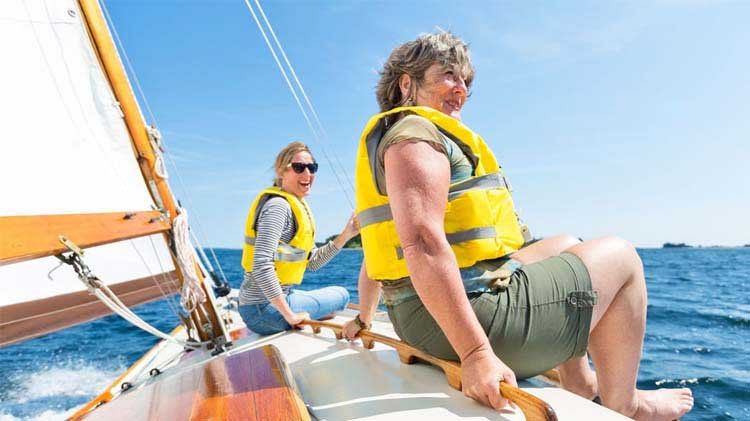Sailing in the USA can be an exhilarating experience, offering stunning views and a sense of freedom. However, safety should always be your top priority to ensure a smooth and enjoyable voyage. This guide provides essential tips on staying safe while sailing, covering everything from equipment to weather conditions and emergency procedures.
Ensure Proper Safety Equipment
Proper safety equipment is fundamental to safeguarding yourself and your crew while sailing in the USA. Start by equipping your boat with essential items such as life jackets, flares, a first aid kit, and a fire extinguisher. Life jackets should be worn at all times and fit each person properly. Additionally, carry distress signals like flares or an EPIRB (Emergency Position Indicating Radio Beacon) to alert rescuers in case of emergency. Having a well-stocked first aid kit and knowing basic first aid procedures further enhances your safety.

Check Weather Conditions Before Departure
Before setting sail, always check the weather forecast for your planned route. Weather conditions can change rapidly, especially in coastal and open waters. Pay attention to wind speeds, wave heights, and the possibility of storms. Be aware of weather warnings and advisories that may affect your sailing plans. By staying informed about the weather, you can make adjustments to your itinerary and avoid dangerous conditions.
Learn and Follow Navigational Rules
Understanding and following navigational rules is crucial for safety while sailing. Familiarize yourself with the International Regulations for Preventing Collisions at Sea (COLREGs) and local maritime laws. These rules govern how vessels should interact to avoid collisions and ensure safe navigation. For instance, knowing which side to pass other vessels on and understanding the significance of navigational markers helps prevent accidents. Adhering to these rules enhances safety for everyone on the water.
Plan Your Route and Monitor Your Position
Planning your route in advance helps you navigate safely and efficiently. Use nautical charts and GPS systems to chart your course and identify potential hazards. Continuously monitor your position using GPS and regular chart updates. Be aware of any navigational hazards such as shallow areas, submerged objects, or busy shipping lanes. Planning and monitoring your route help you avoid unexpected obstacles and stay on course.
Maintain Regular Communication
Maintaining regular communication is key to ensuring safety while sailing. Keep in contact with other boats, marinas, or coast guard stations using a VHF radio. Establish a communication plan with someone on shore who knows your itinerary and can alert authorities if you don’t return as planned. Regular communication helps keep you informed about conditions and provides a backup if you encounter difficulties.
Prepare for Emergencies
Being prepared for emergencies is essential for safe sailing. Develop an emergency plan that includes procedures for various scenarios, such as man overboard, fire, or flooding. Ensure that all crew members are familiar with the plan and their roles during an emergency. Practice drills to simulate emergency situations and improve response times. Having a clear plan and practicing it helps you handle emergencies more effectively and calmly.
Stay Aware of Other Vessels
Situational awareness is vital for avoiding collisions and ensuring safe sailing. Always keep a vigilant lookout for other vessels, especially in busy or congested areas. Use navigation aids such as radar and AIS (Automatic Identification System) to track nearby vessels. Maintain a safe distance from other boats and follow maritime traffic rules to prevent accidents. Staying aware of your surroundings helps you react promptly to potential hazards.
Adhere to Safe Sailing Practices
Adhering to safe sailing practices is crucial for preventing accidents and ensuring a smooth voyage. Avoid overloading your boat, as it can affect stability and handling. Ensure that all equipment is well-maintained and in working order. Follow safe sailing techniques, such as proper sail trimming and weight distribution, to maintain control of your boat. Safe sailing practices help you navigate more effectively and reduce the risk of incidents.
Understand and Manage Tides and Currents
Understanding and managing tides and currents is essential for safe navigation, especially in coastal and river areas. Study tide tables and current charts to plan your sailing activities around predictable water movements. Be aware of how tides and currents can impact your boat’s speed and direction. Managing these factors helps you navigate more smoothly and avoid getting caught in adverse conditions.
Conclusion
Staying safe while sailing in the USA involves a combination of preparation, awareness, and adherence to safety protocols. By ensuring you have the proper safety equipment, checking weather conditions, following navigational rules, and planning your route, you can enhance your safety on the water. Regular communication, emergency preparedness, and situational awareness further contribute to a secure sailing experience. By incorporating these practices, you’ll be well-equipped to enjoy your sailing adventures with confidence and peace of mind.

